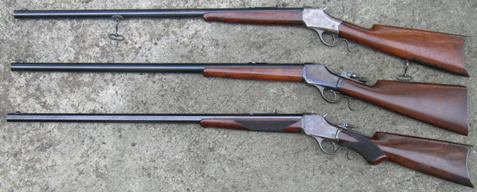From your description, you have a non-ordnance marked 3rd variation Winder Musket. It is very unlikely for it to have been manufactured in the year 1917, as Winchester did not begin production of the 3rd variation until January 1918. What is the serial number? Production of the 3rd variation Winder Muskets took place from January 1918 through June 1920, with a parts clean-up taking place over about an 18-month period after that time. There were 11,419 delivered to the U.S. Army (on four different contracts) in 1918 & 1919. There were at least a few thousand more that were manufactured and sold in the civilian market, most notably in 1919 & 1920 to the NRA Junior Rifle Corps.
Does it have a Lyman No. 53 receiver mounted peep sight? Does the butt plate have a trapdoor in it?
Bert
WACA Historian & Board of Director Member #6571L

Can you post as clear close-up picture of the right-hand side of the receiver frame?
Serial number 119049 was applied in late 1917, and it is right in the middle of a batch of late production 2nd variation (high-wall) Winder Muskets. I have thus far surveyed serial numbers 119005, 119057, 119060, 119063, and 119065, all verified as 2nd variation high-wall Winder Muskets (in 22 Long R.) . The 2nd variation Winder Muskets used a barrel mounted Springfield Krag Model 1901 wind-gauge rear sight.
I would like to see pictures of your Winder Musket, to include the seem between the lower tang and the receiver frame.
Bert
WACA Historian & Board of Director Member #6571L

[email protected] said
Hope these help I can get more if needed ,once again thanks for any info !!
Appears to be a high wall. Bert will clear it up.
It is definitely a 2nd variation high-wall versus a 3rd variation low-wall. Most of the 2nd variation Winder Muskets were chambered for the 22 LONG R. (long rifle) cartridge… are you sure that it is a 22 SHORT ?
The rear sight is a Springfield Krag Model 1901 wind-gauge, and was standard on the 2nd variation Winder Muskets.
The 2nd variation Winder Muskets were introduced in December of 1911, and discontinued in mid-year 1918 (replaced by the 3rd variation). The exact number of them that were manufactured is unknown, but my research survey estimate is 4,000 – 4,200.
Bert
WACA Historian & Board of Director Member #6571L

[email protected] said
Barrel stamped 22 short
Thanks. I took a look at my research survey, and thus far I have a total of (535) 2nd variation Winder Muskets documented, and of that number (118) of them are in 22 Short.
Bert
WACA Historian & Board of Director Member #6571L

November 4, 2017
 Offline
OfflineThanks for the info ,not many produced like this one ,I guess that’s good not much of an 1885 guy I have another hi wall in 32-40 target not in as in nice shape ,does this make it anymore collectible than other winders ?
I personally collect 1886’s 1892’s and Model 71’s
In answer to your question, No, it does not make it more collectable. The Winder Muskets that collectors go after are the U.S. ordnance marked 3rd variations, and the 1st & 2nd variation Winder Muskets in 22 Long Rifle, especially those with a Take Down receiver frame. The high-wall Winder Muskets in 22 Short are less common, but are the least desirable.
Bert
WACA Historian & Board of Director Member #6571L

Hello Matt,
If you have a Model 1885 Winder Musket chambered for 22 Short, it should not fully chamber a 22 Long Rifle cartridge (unless it has been modified). Further, the rifling twist rate in the 22 Short chambered barrel is too slow to properly stabilize the heavier 22 LR bullet, resulting in poor accuracy.
In regards the strength question, for action is plenty stout enough. I have a Winder Musket converted to shoot the 22 K-Hornet (an improved & stouter variant of the 22 Hornet cartridge).
What is the serial number on your Winder Musket?
Bert
WACA Historian & Board of Director Member #6571L

1 Guest(s)


 Log In
Log In Members
Members Home
Home

 Add Reply
Add Reply Add Topic
Add Topic




















